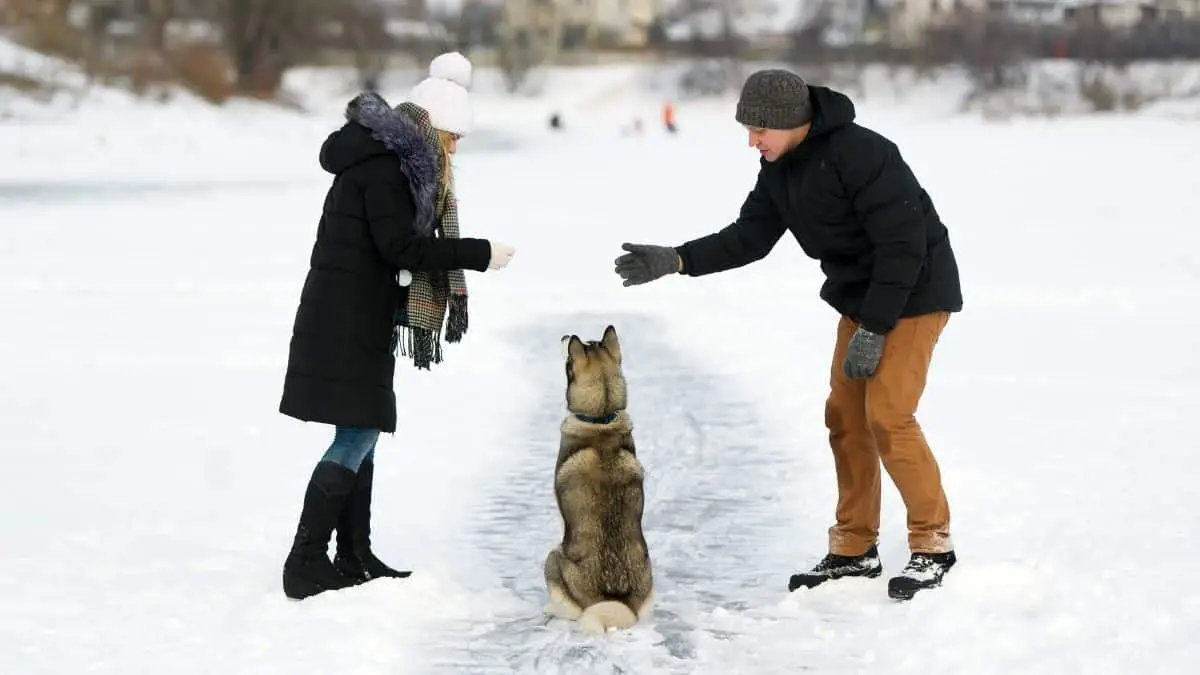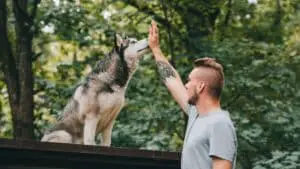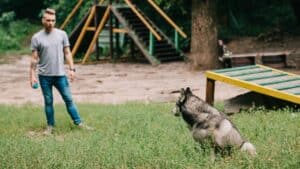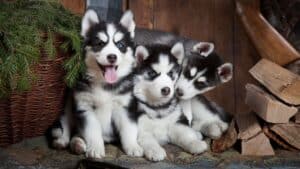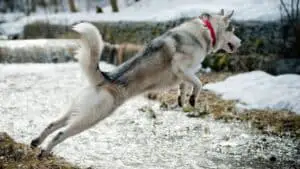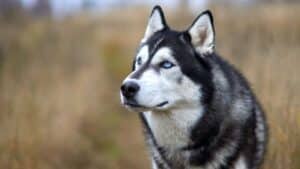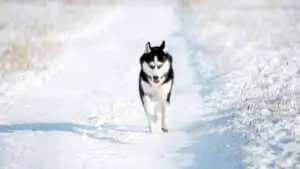How To Train A Siberian Husky (All Methods Explained)
One of your most important tasks as a new (or even not-so-new) Husky owner is to embark on a proper training program with your Siberian Husky. As well as providing an outlet for these high energy dogs, training your Husky is a great means of bonding and will ensure you have a long and happy life together.
There are many aspects to training Huskies. As well as instructing your Husky pup in basic commands, you will also need to become familiar with the basics of crate training, potty training, leash training, and even managing your Husky’s separation anxiety. While most of these training methods typically apply to Husky puppies, they also work well for adult dogs too.
Whatever you are teaching your Husky pup, and however old that particular ‘pup’ is, the most important thing to remember is that you will need to use plenty of positive reinforcement, and establish a consistent, committed process with your training. These are two of the most important training tips you will ever learn, and will be key to your success when training Huskies.
Table of Contents
Background on your Husky: why training is important
Although they have a reputation as stubborn, hard-headed dogs, Siberian Huskies actually respond well to proper training. They are extremely intelligent, and their origins as pack animals and sled dogs mean they are naturally inclined to respond well to your command.
Bred to pull heavy sleds over long distances in difficult terrain, Huskies are genetically inclined to perform strenuous duties. This also means that they are extremely energetic dogs. If this energy is not given proper direction through effective training, it can lead to negative behavior.
Without a consistent, committed approach to training on behalf of the Husky owner, your dog may start to demonstrate some bad traits such as running off, biting, chewing, and even aggression towards smaller animals. It is therefore crucial to know how to train your Siberian Husky.
Getting started: the initial steps
When you bring your dog home for the very first time, it can be daunting to consider how much he has to learn, and how much you have to teach him.
It should put your mind at ease to learn that one of the best training techniques is simply starting simple. By setting a foundation for your Husky’s training with simple goals that are easy to achieve, you stand the best chance of long term success in your training endeavors.
We’ve outlined some very simple training tips and techniques below that can help you get started with your Husky training.
A Husky by any other name…
First and foremost, the most important thing you can teach your Husky is his very own name! This is the first thing your dog should know so that you use his name to get his attention. It is inevitable that your dog will try to ignore you sometimes. Therefore, teaching him his name will help you catch his attention and convey your command more easily.
To teach your Husky his name, you will need to do the following. Begin in a small enclosed area – anywhere in your home will do. Wait until your Husky puppy is not looking at you, then say his name. When he turns to look at you, say ‘yes’ or ‘good’ in a bright, positive tone, and immediately give him a treat.
After a while, your positive reinforcement will teach your pup to expect good things whenever he hears his name, and he will react accordingly. Don’t worry, you won’t have to always give him treats whenever you say his name! Once your Husky puppy has the hang of it, you can start to ease back on the treats until you no longer need to give them.
Making friends with your Husky
One of the next important things is to socialize your dog. Let him play with other dogs and become familiar with other people. Huskies are naturally social dogs – they are pack dogs after all! – and will relish the company and attention. Playing and socializing will help regulate your Husky’s behavior as he takes his cues from other dogs.
Of course, it is important that you remove your Siberian Husky if you notice any sign of aggression, although with the correct behavior training, this should never be an issue.
Take command with basic commands
This is where things start to get a little more exciting. Although not the most exciting trick in the book, teaching your Husky puppy basic commands such as ‘sit’, ‘stay’, and ‘down’ are some of the best ways to teach your Husky proper behaviors, as well as teaching him to obey you.
There are a couple of important things to note before you begin teaching your Husky pup commands. Firstly, begin by training him in a single command at a time. Anything more will likely confuse your dog and lead to frustration for both you and him!
Secondly, remember that Huskies – particularly Husky puppies – have relatively short attention spans. Pay attention to your dog’s body language when you are training him. As soon as he starts to become listless and bored, move on. You always want training to be a happy, positive experience!
Got all that? Great! Let’s move on to the fun stuff.
The American Kennel Club suggests that whenever you are teaching basic commands, you start off with small, simple steps, and then build up to more complex behaviors.
For example, when teaching your puppy to ‘come’, begin by sitting on the floor with him, and repeating his name along with the ‘come’ command. Give your pup a treat whenever you say ‘come’ – he doesn’t have to do anything yet, so it doesn’t get much easier than that!
Then start to add distance, tossing the treat a little further away and issuing the command and saying his name over and over again. Once you have added sufficient distance, start to jog a few steps away from your pup when you say the command. Your pup will love the thrill of chasing after you, and with plenty of petting and positive reinforcement, he will learn that the ‘come’ command is great fun for him!
Instructing your pup in other basic commands will follow the same principle: starting off small and familiarizing your Husky with the command word, ensuring he receives a treat every time he obeys you, then working up to more complex actions and behaviors.
Potty training: the best tips and tricks
Arguably one of the most important lessons your Husky will ever learn is proper house training behavior. As with any aspect of training, there will be an inevitable accident or two when you are potty training. The most important thing you can do is accept these accidents and move on, no matter how smelly it gets!
Be consistent when you begin potty training your Husky pup. If you have your Husky on a regular feeding schedule, you will find it much easier to monitor his bathroom habits. Control his access to food and water in the evenings, so that you don’t awake to a nasty surprise in the morning!
One of the easiest ways to teach your Husky puppy that he needs to do his business outdoors is by taking him outside at the same, regular intervals every day. These include:
- When your puppy wakes up
- After your puppy has eaten
- After your puppy has had something to drink
- After your puppy has had a nap
- After your puppy has been playing
- Before your puppy goes to sleep
Whenever your puppy does his business correctly, be sure to reward this good behavior with plenty of positive reinforcement. This teaches your pooch that going outdoors is a happy, positive experience, and means he is much less likely to make a mess of your carpet!
These paws are made for walking…
Everyone knows that going for walks is one of your dog’s favorite activities. But when it comes to walking a Siberian Husky, it can sometimes feel like your dog is taking you for a walk instead!
Enter loose leash training. This will help your dog walk calmly by your side, rather than pulling rapidly ahead. It will also help them understand correct behaviors when it comes to off-leash times, and may help prevent them from running away as soon as you unclip their harness!
Similar to command training, loose leash walking is achieved through consistency and plenty of positive reinforcement. Establish firm rules when it comes to walks, and make sure you stick to them.
The following process may help you in establishing effective loose leash walking behavior. Be sure to bring plenty of treats for your Husky puppy when you go on these walks, at least in the initial stages.
- When your puppy starts pulling against his leash on a walk, stop and take several steps backward.
- Call your Husky while you step backward, keeping your tone upbeat and positive. Reward him when he comes to your side.
- Start walking again. Reward your puppy every few yards if he continues to walk calmly by your side.
- Repeat the above steps every time your puppy begins to pull at his leash.
In doing this, you will help your Husky overcome his natural prey drive, which essentially encourages him to race after every small animal he sees, in the hope that it might be prey! This is, of course, extremely bad behavior, and needs to be eradicated as soon as possible.
Can my older Husky be trained too?
Absolutely! While it is always best to start training your Husky as soon as possible, that doesn’t mean that your older Husky cannot be taught or trained.
In fact, you will use the same principles of consistency and positive reinforcement with your adult Husky, but just be aware that it may take a bit more time to sink in, as your older dog will already have learned some behaviors and tendencies that might require some time to overcome.
Just as you would with a puppy, stay patient with your older dog. Allow them time to adjust to the new routines and processes you are asking of them.
Also, don’t be afraid to enroll in obedience classes! Professional trainers can help your older pup to learn new behaviors and respond to new commands, and can also give you a few key tips and tricks for training at home.
How useful is crate training?
We’re not going to lie – crate training can be tricky to handle in the early days. Once you have overcome the initial hurdles, however, you will find that your dog’s crate is a very useful tool in your training arsenal.
A crate can be used for everything from house training to managing your pup’s separation anxiety. It can be equally useful for younger and older Huskies alike, and also represents a place of refuge for your dog within your home.
A few key things to remember when it comes to crate training:
- Don’t use the crate as a place of punishment – it is not the ‘naughty room’!
- Don’t leave young puppies or dogs that are not house trained in the crate for too long.
- Place your Husky in the crate at the same times every day – he will soon become familiar with the routine and even begin to take himself to the crate when he feels the need!
Husky training: the final rundown
When it comes to training your Husky, make sure you have regular and consistent training sessions. Avoid distractions during training time as Siberian Huskies can get bored easily and may not take all your careful instruction on board if they become distracted.
Take training sessions light-heartedly. These sessions are a good bonding time with your Husky, and should never be a time of negativity or stress – a fun training session will be much more instructive for your Husky!
Start small and simple by teaching your Husky basic commands and behaviors and building upon these important foundations as you go. Always use positive reinforcement, rewarding, and praising your Husky when he gets the commands right.

